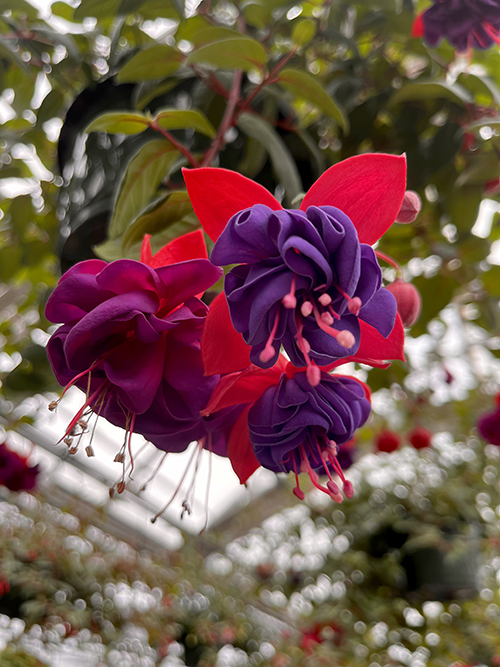Let It Grow
By Tammy Thornton
Have you ever visited a sunny garden bursting with big beautiful flowers and come down with a case of garden envy? You can almost sense those flower heads gloating at you, knowing that when you return home, a plain, shady garden awaits you. Take heart, sun-challenged gardens don’t need to be boring. Shade-loving plants can provide color, interest, and texture. If flowers are your goal, simply choose the proper plants that will thrive in your shady environment.
It is true that plants that call for “full sun” require at least six hours of sunlight per day. If your garden is on the shadier side, it can present some challenges. Even plants calling for partial shade need four to six hours of sun. How closely have you monitored your garden from beginning to end? You may be judging your garden by looking outside at lunchtime and begin to think that you’ve been passed over. However, a few hours of early morning sun or a few hours in the late afternoon may provide the ideal conditions for plants that would otherwise succumb to a full day of harsh direct sun. You may find that some of your favorite plants and flowers need a respite from full sun during the peak hours of the day.
Let’s start with foliage. You can become quite creative with the use of different types of foliage in the garden. Hostas, for instance, come in all kinds of shapes, colors, and sizes. Their leaves can be silver, blue, green, yellow, and white. Add in variegated mixes of these colors and your options are almost limitless. Though hostas are most appreciated for their foliage, they will send up tall stems topped with purple, pink, or white bell-shaped flowers that will attract hummingbirds. You could create an entire garden from hostas alone by combining all of the different types. In my own garden, variegated hostas line the curving path from the front yard to the back. This shady transitional garden gives off a peaceful vibe before you are thrust into the sunny garden in the back. On a hot day, you’ll appreciate the return to this cooler garden, and the greenery, enhanced with a variety of ferns, provides a soothing feeling.

Exotic fuchsia flowers look they are dressed for the gala, but bask in the shady garden.
Coral bells, or heuchera, are the sweethearts of foliage. Their ruffled, heart-shaped leaves can be found in every color from purple and red to chartreuse and peach. Sprays of tiny bell-shaped flowers also come in many different colors that complement the leaves. Though heuchera are deer-resistant, the little flowers will attract butterflies and hummingbirds.
When considering foliage plants for the shady garden, you can’t miss coleus. Though these are annual flowers, they can be easily propagated from cuttings and grown indoors over the winter. Coleus will send up small flowers, but they are insignificant compared to the knock-out foliage with vibrant colors in pink, purple, chartreuse, red, orange, green, or yellow.
Another interesting plant for your shade garden is Solomon’s Seal. The elegantly arching stems and leaves will produce tiny white bell-like flowers that resemble lilies of the valley. You can find these swooping plants with both variegated and non-variegated leaves.
Bleeding hearts have a similar growth habit of arching stems. However, as the name suggests, these plants produce heart-shaped flowers in red, pink, and white, fitting for the romantic gardener. You’ll be smitten with these unique flowers. Plant bleeding heart for early spring interest since as the weather heats up, they will fade away and go dormant. But love will return again the following spring if you take care of this perennial beauty.
My favorite shade-loving flowers have to be hellebores. These elegant belles of the ball bloom just when you have almost lost hope in the winter and everything seems bleak. Just in time, hellebores emerge from their dormancy revealing stunning flowers that nod their heads with a bit of shyness. Each flower can last for weeks making it perfect for cut flowers. The plant itself can bloom for months.
For a touch of the exotic, grow fuschia flowers in your shade garden. A hanging basket of these dramatic flowers will steal the shade garden show. Hummingbirds and other pollinators will love these flowers as much as you will.
Living by the shore, of course we must include our favorite coastal flower — the hydrangea. Inspiring festivals, garden tours, and hydrangea queens, their white, blue, and pink flowers grace cottage gardens all along the East Coast. Hydrangeas thrive in partially shaded gardens but can wilt in the heat. It shows when they get thirsty, so be sure to keep them well-watered. The shady garden will give them the relief they need from the summer sun. You can take cuttings from your favorite hydrangeas to grow new plants for yourself or a friend. Even after the pom-pom flowers fade, they retain their shape and look lovely in dried arrangements.
With a little research, you will realize that a shady garden can be an asset. Flowers that would be overwhelmed by the heat of summer in the sunny garden will thrive in the shade. Creative use of foliage can provide unique interest and exotic flowers will make you want to linger. Pretty soon you want to embrace the peace of a shade garden and realize there’s no place that you’d rather be.
Tammy Thornton lives with her husband, children, and crazy pets while enjoying a life of gardening, cooking, and going to the beach.








